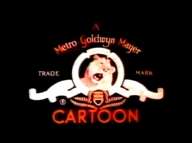MGM Animation/Visual Arts
 | |
| Industry | Animated Feature and short Films |
|---|---|
| Predecessor | Metro-Goldwyn-Mayer cartoon studio |
| Successor |
Metro-Goldwyn-Mayer Animation Warner Bros. Animation (library only) |
| Founded | 1962 |
| Founder |
Chuck Jones Les Goldman |
| Defunct | 1970 |
| Owner | Time Warner (library only) |
| Parent | Turner Entertainment (library only) |
MGM Animation/Visual Arts was an American animation studio established in 1962 by animation director/producer Chuck Jones and producer Les Goldman as Sib Tower 12 Productions. It is noted for productions such as the last series of Tom and Jerry theatrical shorts, the TV specials Horton Hears a Who and How the Grinch Stole Christmas!, and the feature film The Phantom Tollbooth, all released by Metro-Goldwyn-Mayer.
History
The studio began as "SIB Productions" which released the film's by Norm Prescott. He left the studio to launch Filmation, while the studio evolved into "Sib-Tower. 12, Inc." The logos of SIB Produtctions, Sib-Tower 12, Inc., and the pre-1982 logo of Filmation all bear a downwards pointing chevron. The studio was founded when Chuck Jones was fired from Warner Bros. Cartoons, where he had served for over 30 years, directing the Looney Tunes and Merrie Melodies series, Sib Tower 12 Productions received a contract from Metro-Goldwyn-Mayer to produce a new series of Tom and Jerry cartoons, with a number of animators who had worked under Jones during his Warner Bros. career following him to Sib Tower 12, notably Michael Maltese and Mel Blanc. These shorts proved successful, and MGM purchased the Sib Tower 12 studio and renamed it MGM Animation/Visual Arts in 1964.[1] This studio continued with Jones' Tom and Jerry shorts until 1967.
In addition to the Tom and Jerry cartoons, Jones worked on one other short. The Dot and the Line (1965), was an abstract piece based upon a children's book by Norton Juster. It won the 1965 Academy Award for Animated Short Film.
The studio also turned to television, producing two highly acclaimed TV specials. The first was a 1966 adaptation of Dr. Seuss' How the Grinch Stole Christmas!. The second was another Seuss adaptation, Horton Hears a Who!, which first aired in 1970.
The studio's most ambitious work was its 1970 feature film The Phantom Tollbooth, adapted from another Norton Juster book.
Filmography
Theatrical cartoon shorts
- Tom and Jerry (1963–1967)
- The Dot and the Line (1965)
- The Bear That Wasn't (1967)
Television shows
- Off to See the Wizard (1967–1968)
Television specials
- How the Grinch Stole Christmas! (1966)
- The Pogo Special Birthday Special (1969)
- Horton Hears a Who! (1970)
Feature films
- The Phantom Tollbooth (1970)
See also
Notes
- ↑ Lemay, Brian. "History of Animation: 1961 - 70". Retrieved from http://www.brianlemay.com/History/timeline1961-1970.html on September 10, 2006.
References
- Maltin, Leonard, Of Mice and Magic: A History of American Animated Cartoons, New York: NAL Books, 1987, ISBN 0-452-25993-2